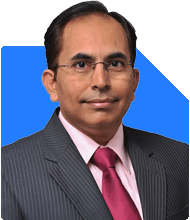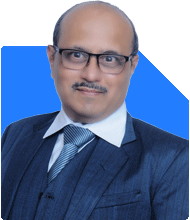Ramalingam Kalirajan |10894 Answers |Ask -Follow
Mutual Funds, Financial Planning Expert - Answered on Jun 23, 2025
He has an MBA in finance from the University of Madras and is a certified financial planner.
He is the director and chief financial planner at Holistic Investment, a Chennai-based firm that offers financial planning and wealth management advice.... more

Why do you want to retire at the age of 51?
You are still young at 51
You may live till 85 or more
You need money for next 30+ years
You must plan with care and purpose
Retirement is not just about stopping work. It is about starting a new life phase.
Ask yourself:
What will I do every day?
How will I keep myself mentally strong?
Will my money last till the end?
Without clear purpose, early retirement becomes boring. With purpose, it becomes powerful.
Possible Reasons to Retire at 51
1. Health and Mental Freedom
Body slows down with age
Stress takes a toll after 50
You may want rest and peace
You want time for yourself and family
Many people retire early due to health issues. But do not wait till health fails.
Plan smart. Build peace with power.
2. You Want More Time with Family
Your children may become adults soon
Parents may need more support
You want to travel with spouse
You may want to stay closer to home
This is a deep emotional reason. And a valid one.
Time lost with family cannot be earned back.
3. You Want to Pursue a Passion
You love writing, music, farming, or teaching
But your job doesn’t allow it
You want to work on your dream projects
Or serve society through volunteering
Retirement here doesn’t mean stopping work. It means switching work. That’s smart.
4. You Are Financially Ready
You have no debt
You have 30+ years of cash flow ready
You don’t want to work just for money
You have passive income set up
If money is not a problem, freedom becomes the goal.
Retirement is not about age. It is about readiness.
5. You Don’t Enjoy Your Current Job
Your work drains you
You feel stuck in routine
You are not growing
You want a break to reset life
This is valid too. But plan it carefully.
Don’t retire in anger. Retire in clarity.
Key Things You Must Think Before Age 51
1. How Much Money Will You Need
Life will go on for 30–35 more years
You will need monthly income till end
Inflation will make things costly
Healthcare costs will rise a lot
You need a plan for income, not just savings.
2. Where Will the Money Come From
Do you have mutual fund corpus?
Do you have pension income?
Is your spouse earning?
Do you have passive income sources?
You need 3–4 sources of income after 51.
If you depend on one source, risk increases.
3. Have You Cleared All Loans
No credit card loan
No home loan
No personal or vehicle loan
You must enter retirement debt-free.
Debt in retirement kills peace.
4. Is Your Family Protected
You must have term insurance till 60
You must have health insurance
You must have emergency fund
You must have will and nominations ready
Family safety brings real freedom. Not just early exit from job.
Mental and Emotional Factors
Retirement can feel lonely. So ask:
Will I miss office friends?
Will I get bored at home?
Do I have new hobbies ready?
Am I mentally strong to handle changes?
You are not retiring from life. You are retiring from job.
So build a happy lifestyle plan. Not just money plan.
Don’t Retire Too Early Just for These Reasons
You hate your current boss
You feel tired this year
You want to copy someone else
You think stock market will fund everything
These are poor reasons to retire early.
Build a goal-based, reason-backed plan.
Financial Tools to Support Retirement at 51
You must use these tools:
Actively managed mutual funds for growth
Diversified portfolio across equity and debt
Emergency fund of 12–18 months
Separate funds for kids and personal use
Monthly income plan from mutual fund SWP
Avoid index funds and ETFs
Do not use direct funds
Use regular mutual funds through MFD with CFP. You will get review and right guidance.
If You Have LIC or ULIP
Check their performance
Most give poor returns
Surrender them if not useful
Reinvest in actively managed funds
Only do this with proper guidance from Certified Financial Planner.
Finally
Retiring at 51 is possible. But only with a clear reason and strong planning.
Before taking decision:
Know why you want to retire
Know what you will do after that
Know how money will come every month
Know if family is safe and secure
Retire early. But retire wisely.
Best Regards,
K. Ramalingam, MBA, CFP,
Chief Financial Planner,
www.holisticinvestment.in
https://www.youtube.com/@HolisticInvestment
You may like to see similar questions and answers below
Ramalingam Kalirajan |10894 Answers |Ask -Follow
Mutual Funds, Financial Planning Expert - Answered on May 26, 2024
Ramalingam Kalirajan |10894 Answers |Ask -Follow
Mutual Funds, Financial Planning Expert - Answered on Jan 29, 2025
Janak Patel |71 Answers |Ask -Follow
MF, PF Expert - Answered on Oct 06, 2025
Patrick Dsouza |1429 Answers |Ask -Follow
CAT, XAT, CMAT, CET Expert - Answered on Dec 16, 2025
Nayagam P P |10858 Answers |Ask -Follow
Career Counsellor - Answered on Dec 16, 2025
Nayagam P P |10858 Answers |Ask -Follow
Career Counsellor - Answered on Dec 16, 2025
Samraat Jadhav |2510 Answers |Ask -Follow
Stock Market Expert - Answered on Dec 16, 2025
Samraat Jadhav |2510 Answers |Ask -Follow
Stock Market Expert - Answered on Dec 16, 2025
Nayagam P P |10858 Answers |Ask -Follow
Career Counsellor - Answered on Dec 16, 2025
Nayagam P P |10858 Answers |Ask -Follow
Career Counsellor - Answered on Dec 16, 2025
Ramalingam Kalirajan |10894 Answers |Ask -Follow
Mutual Funds, Financial Planning Expert - Answered on Dec 16, 2025
Nitin Narkhede |113 Answers |Ask -Follow
MF, PF Expert - Answered on Dec 15, 2025
Nitin Narkhede |113 Answers |Ask -Follow
MF, PF Expert - Answered on Dec 15, 2025























